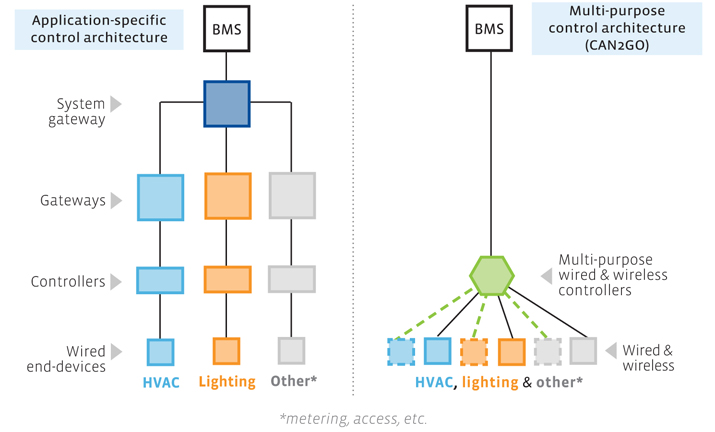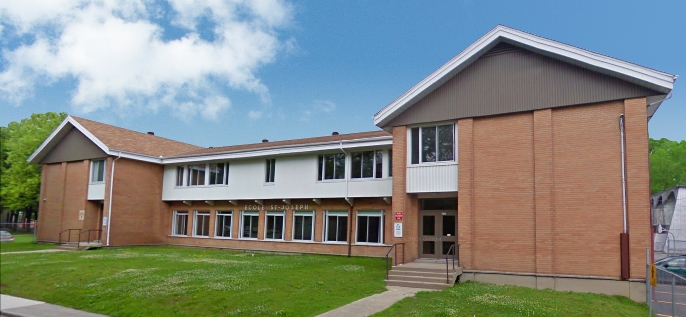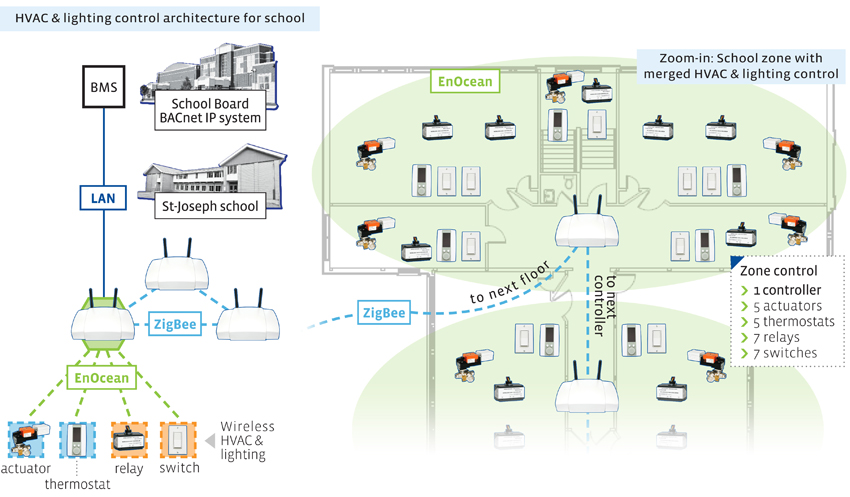|
October 2011
Article
AutomatedBuildings.com
|
[an error occurred while processing this directive]
(Click
Message to Learn More)
|
HVAC vs. Lighting: the open language we’re
really looking for
The
scenario of combined (or merged) HVAC and lighting control can be
easily achieved .
|
|
The current debate
about an open language for building automation
systems (BAS), whether based on IEC 61131-3, an expansion of BACnet or
another solution is forcing me to underline a much more absurd division
within the BAS world: the divide between HVAC and lighting control.
If you look at market data in commercial buildings, there is a ratio of
five HVAC BAS for every lighting BAS. This means that scaling from one
system to the other is complicated, even though components of both are
always occupying the same spaces. Furthermore, looking at the
industry’s structure, you’ll notice that many manufacturers and
contractors are either specialized in one or the other. They rarely do
both; sometimes because of regulatory hurdles, but sometimes because
they lack the solution to do it.
Some companies do offer combined solutions, but even there, the two
“systems” are far apart. There are controllers and gateways for HVAC,
and separate control hardware for lighting, with notoriously costly
“system gateways” to bridge everything together. Things should be much
simpler considering that in most cases, HVAC and lighting deal with the
same basic language of analog and digital inputs and outputs.
A costly mistake
This divide has had a steep cost for system integrators, building
owners and facility managers. For owners and managers, the high
hardware and software costs of installing each system has pushed them
to choose between the two instead of gaining the energy efficiency
advantages of both. When parallel systems (non-integrated) are
installed, it also increases the time and resources dedicated to manage
both.
It would be much more cost-effective for all stakeholders to be able to
use a single room or zone controller to handle both HVAC and lighting
applications at the same time.
Merging HVAC & lighting control
The scenario of combined (or merged) HVAC and lighting control can be
easily achieved by using CAN2GO controllers. Here is a diagram
comparing the traditional application-specific BAS architecture to the
CAN2GO multi-purpose system architecture:

On the left,
the traditional architecture requires much more hardware and
installation labor (wiring, repair) than the CAN2GO architecture on the
right.
Using wired & wireless programmable controllers to merge HVAC and
lighting control holds many advantages for buildings owners, facility
managers and contractors.
- The first advantage of the
merged scenario is at
installation. Less hardware is needed, and wiring/repair work is
greatly reduced. This lowers the total cost of ownership of the system
and shortens the payback period for a faster return on investment.
- The second advantage is greater
energy savings,
comfort and efficiency. A building with both HVAC and lighting control
saves more than a building with just one or the other. Remember that in
an office building for example, HVAC represents about 50% of energy
use, while lighting represents close to 20%.
- The third advantage is reduced
maintenance and
management costs. Because both HVAC and lighting can be controlled from
a single interface, management personnel only have one interface to
learn and monitor. Since HVAC and lighting are already talking, it’s
also much easier to coordinate schedules and events that call upon both
applications.
- The fourth advantage is
scalability over time. When
a single controller can take in both HVAC and lighting points, you can
decide to add other points during the life cycle of a building, without
having to install additional control hardware. This, again, saves time
and money, while increasing energy efficiency. For example, installing
those extra occupancy, lighting or CO2 sensors becomes very
cost-effective if you can reuse the controller that is already in
place. That is the case with CAN2GO.
Case study: K-12 school and school board
The St-Joseph school of the Samares school board near Montreal (QC,
Canada) is a fitting example of the seamless and cost-effective use of
merged HVAC/lighting control. Furthermore, by using the CAN2GO system,
the contractor estimated saving 61% on electrical labor and 32% on
controller costs compared to his usual building automation system.

The St-Joseph elementary school had no remote or programmable control
of its lighting or HVAC. The only thing the school had was central
heating without any thermostats in classes or hallways and a typical
ballast lighting installation without any zones. Besides adding better
in-room and remote programmable control for both heating and lighting,
St-Joseph required a system that could push points upstream to the
existing BACnet IP system being used by the school board. The school
board also had other requirements: no cancelation of classes, no extra
charges for installing the system overnight or on weekends and no dust
hazards for the children.
CAN2GO controllers were chosen for the project because any single unit
could manage thermostats, actuators, relays and light switches at the
same time. The control of these end-devices is done via EnOcean
wireless communication. The controllers also network wirelessly, via
ZigBee mesh. The only wired connections required for the entire
installation were to power up the controllers and actuators, and one
Ethernet connection to the LAN, to push the BACnet points to the school
board’s system.
For the two main floors of the school, about 18,000 square feet, only
nine CAN2GO units were needed to control 60 HVAC end-devices
(thermostats, actuators) and 116 lighting end-devices (relays,
switches).

On the left,
the network architecture going all the way up to
the School board. On the right, a close-up look at one of the zones
where all the control and networking is wireless.
[an error occurred while processing this directive]
“Our school board had
the opportunity to install the CAN2GO line. It
gave us a full BACnet integrated building automation system combining
both HVAC and lighting control. All the communication to and from
controllers and end-devices is wireless, so the installation process
caused no downtime or repair work, an immense advantage over other
alternatives. We plan to install CAN2GO in upcoming retrofit projects”,
said Michel Morin, Coordinator of Energy Management at the Samares
School Board.
Building automation’s missing link
The demand has been growing rapidly for more cost-effective energy
management solutions. There is a reason why the penetration rate of
building automation systems is half what it should be. In buildings
over 100,000 square feet, barely 45% to 50% of buildings have a BAS. In
light commercial and mid-market buildings (smaller than 100,000
sq.ft.), it’s a measly 5%. The problem is that traditional BAS – mostly
wired and application specific – do not provide the right return on
investment and payback period for building owners and facility managers.
Using fully programmable controllers with strong wireless capabilities
is one way to provide energy efficiency to commercial buildings at a
better price, and without the invasiveness of traditional solutions.
Think of the possibilities: one controller can offer simultaneous wired
and wireless control for lighting and HVAC applications, with in-node
support for BACnet, IP/Ethernet, CANbus, Modbus, EnOcean and ZigBee.
This is not a pipe dream; it’s reality. A ubiquitous open programming
language would be nice for our industry. But getting HVAC and lighting
to talk to each other and lowering the cost of ownership of BAS through
the use of wireless technology is much more urgent.
For more information about CAN2GO, visit us at WEEC in Chicago (booth
#404) or at Greenbuild in Toronto (EnOcean Alliance booth # 6336S).
www.can2go.com
footer
[an error occurred while processing this directive]
[Click Banner To Learn More]
[Home Page] [The
Automator] [About] [Subscribe
] [Contact
Us]


